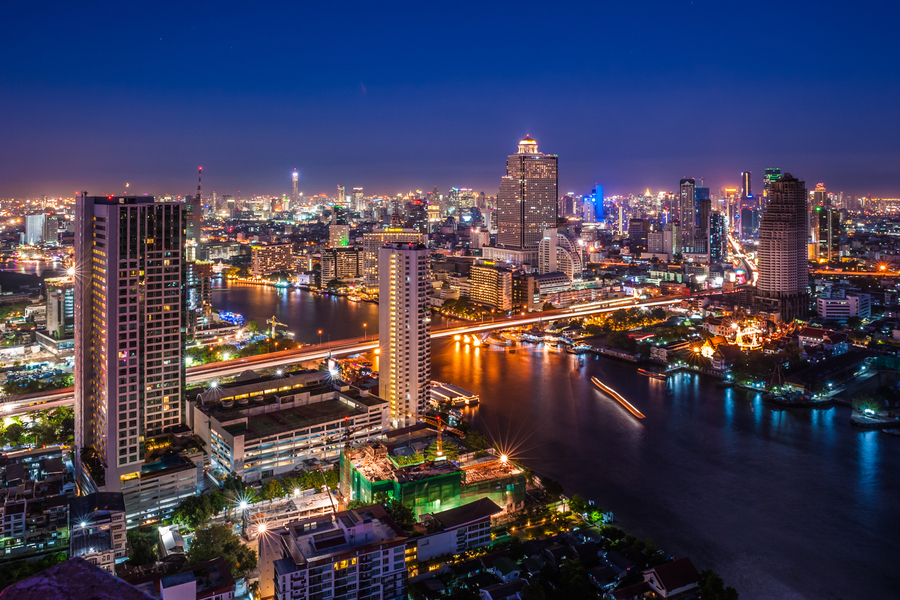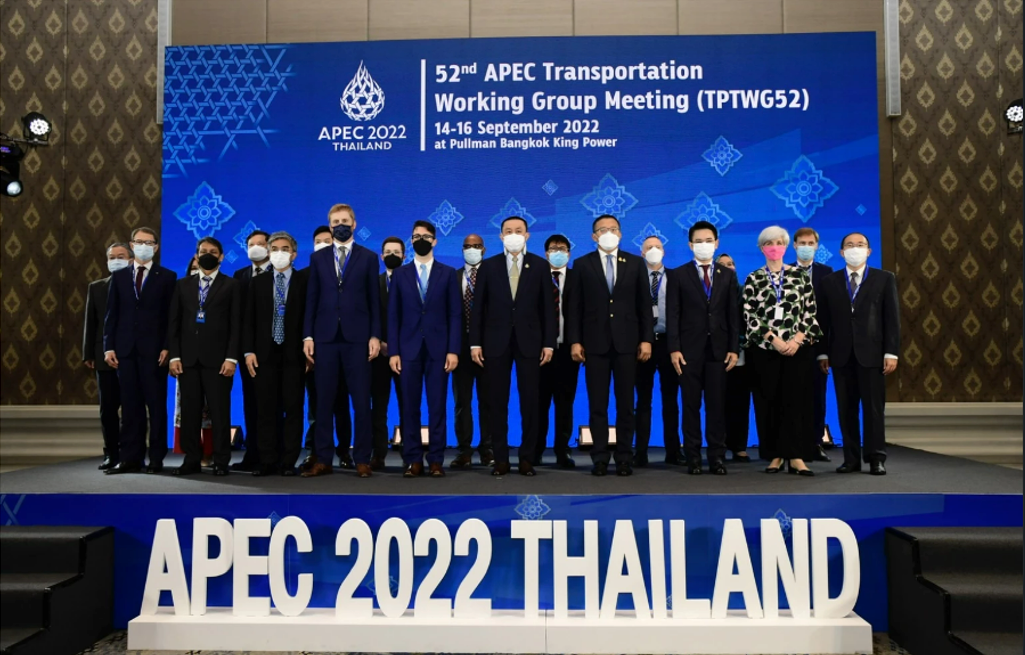
Why Thailand
(OCT22) Connecting hub

1. Strategic Location
Thailand is a key link between countries in Asia, with economic ties across the region that include the transfer of goods, services, skilled labour, trade, and investment. As such, Thailand is the gateway to ASEAN and Asia, and is an important production and export base for many of the world’s major industries including automobiles, computer components, IT, and more.
- Exports
Thailand’s exports for July 2022 were valued at US$23,629,300,000, an increase of 4.3% over July 2021. In the first seven months of 2022, Thai exports grew 11.5% for a total value of US$172,814,100,000. The growth in Thai exports was largely due to agricultural and agro-industry products and driven by higher global prices for agricultural and food commodities, with the world’s production output still affected by a number of factors such as the reduction in grain exports from Ukraine. Overall exports of industrial products grew slightly despite semi-conductor manufacturing being impacted by lockdowns in major Chinese industrial cities which hindered production and delivery. Some product categories, however, continued to see export growth, in particular sectors like gems and jewellery, cosmetics, soaps and skincare products, apparel, etc. which benefitted from the relaxation of epidemic control measures. Thai exports are forecast to show continued improvement in the second half of 2022 and there is confidence that the growth will reach 6-8%, above the previously expected 5%.

Photo credit: Bank of Thailand
- Investment in Thailand
A recent report from the Foreign Business Operations Committee of Thailand revealed that during the first seven months of 2022 (January – July), 323 foreigners were given the green light to invest in Thailand - 122 business licences, and 201 business certificates – with a total foreign investment of THB73,365,000,000, and employing more than 3,308 Thai nationals. Most of these business licences were for businesses in compliance with the government’s investment promotion policies, and those supporting the country’s targeted industries, such as those involved with the design, construction, installation, and inspections of the energy storage system for the integrated power plant project supporting U-Tapao Airport.
The service uses the Application platform and website for the transportation of personnel and goods, and the purchase of goods and services. The top five nationalities of foreign investors were Japan (82), Singapore (58), USA (40), Hong Kong (26), and China (14). It is expected that foreign investors will continue to apply to do business in Thailand throughout the rest of 2022 as a result of the government’s investment promotion and economic stimulus measures. Such measures increase the convenience for prospective investors resulting in more applications, which will continue to stimulate the nation’s economic recovery.
- In its macro-economic policy management from September to December 2022, the government has emphasized:
- Tracking and supervising market movements to ensure product prices remain in line with production costs, in tandem with mechanisms to protect low-income groups and those most vulnerable to rising commodity prices and interest fluctuations.
- Overseeing agricultural production and farmers’ income.
- Monitoring and resolving debt issues for households and small and medium enterprises (SMEs) amid rising interest rates.
- Maintaining the export drive.
- Supporting the recovery of tourism and related services.
- Encouraging private investment.
- Driving public spending and investment.
- Monitoring and preparing appropriate support measures during the period of global economic and financial volatility and geo-political conflicts.
2. Easy Access
After its successful handling of the Covid-19 crisis, Thailand was selected by fellow ASEAN members as the location for the Secretariat for the ASEAN Centre for Public Health Emergencies and Emerging Diseases (ACPHEED), an important undertaking and a development that was pushed by the Thai public health team. ACPHEED has a key role to play in strengthening the grouping’s preparation for prevention, detection, and response to public health emergencies and emerging diseases. As a centre of excellence and a human resource centre for the region, it brings significant benefits to Thailand: helping reduce the medical and public health expenditure that supports the screening, immunization, examination, treatment, and epidemic control of foreign workers from the region who are working in Thailand, and building confidence among investors, tourists, and MICE travellers coming to the country.
- Thai airlines are opening more routes and increasing the number of flights
Thai airlines have begun to increase the number of routes and flights, driving an increase in the number of incoming passengers and revenue to the country as it continues to recover from the impact of the Covid-19 pandemic.
- Thai AirAsia is preparing to open international direct flights in October 2022, including Bangkok-Fukuoka (Japan); Chiang Mai-Hanoi and Chiang Mai-Danang (Vietnam); and Bangkok-Gaya (India). From November 2022, the additional routes Bangkok-Kathmandu (Nepal) and Bangkok-Dhaka (Bangladesh) will be added.
- Thai AirAsia X – In October 2022, Thai Air Asia X will begin offering direct flights between Bangkok and New Delhi (India) and in November will add direct flights from Bangkok to Australia’s two major cities, Sydney and Melbourne. The frequency of flights on the airline’s services to South Korea and Japan will also increase.
- Thai Vietjet – From October 2022 Thai Vietjet begins a new service between Bangkok and Phu Quoc (Vietnam), and will increase the frequency of flights between Bangkok and Fukuoka (Japan) to five flights per week, and Bangkok-Taipei (Taiwan) to twice a week.
- Bangkok Airways is preparing to resume its services between Samui and Krabi in late 2022, and in early 2023 will begin flights between Samui and Hong Kong, with plans to add Samui-Chengdu, and Samui-Chongqing services in the near future to meet the demand from Chinese tourists wanting to fly direct to the island.
- Nok Air is preparing to increase the frequency of its flight services between Bangkok and Yangon (Myanmar) to nine flights per week and Bangkok-Ho Chi Minh City (Vietnam) from daily to twice daily services. Other routes, including flights to a number of Indian destinations are awaiting approval.
- Mega Projects
The Ministry of Transport’s “Land Bridge” project proposes an economic bridge that connects the Gulf of Thailand with the Andaman Sea as a new shipping route which would open a new gateway to the global economy pushing Thailand as a logistics centre for the ASEAN region. The project will use Singapore’s Tuas Port, which aims to become the world’s largest container terminal which can support 65 million TEU containers in the next 20 years, as a prototype. Thailand has the great advantage of being geographically located in the centre of the region and able to connect sea freight conveniently, safely, and at a reasonable cost. According to projections it is expected that the project will commence after 2023 and be completed by 2030. The project would be a collaboration with foreign partners with national shipping lines. It would be a model for the management of two ports operating simultaneously as one entity (One Port Two Sides), and both a sea transportation and economic connection point which will change the regional mode of transportation of goods. The facility will connect with ground transportation – both road and rail – managed as part of the country’s motorway integration plan to connect dual track rail lines (MR-MAP) and create a seamless link between APEC economic zones.

3. New Development
- Communication System Development
The Thai government is actively promoting the Thai rail system to become the country’s main public transportation system with the aim of reducing traffic congestion in Bangkok and its surrounds, to improve people’s quality of life, and to support the city’s continued expansion. It also serves to support the many MICE travellers coming to Thailand to organise and participate in events. The government is accelerating the pace of construction in line with its master plan:
- The MRT Orange Line project from the Thailand Cultural Centre to Min Buri (Suwinthawong)
- The MRT Yellow Line project from Lad Prao to Samrong.
- The MRT Pink Line project from Khae Rai to Min Buri.
The construction progress of all three projects is currently on schedule. The two monorail projects – the Yellow Line from Lad Phrao to Samrong, and the Pink Line from Khae Rai to Min Buri – will have their virtual trial runs in October 2022 before beginning full services in 2023. Civil construction of the Orange Line from the Thailand Cultural Centre to Min Buri (Suwinthawong) has now reached 95% completion and the service is expected to open in 2025.
- Technological Development
SCG has developed the innovative “SCG Bi-ion Air Purification System” as part of its efforts to improve air safety standards in buildings. The ion system eliminates pathogens in the air, and releases positively- and negatively-charged particles which are effective in killing air-borne viruses and bacteria, as well as reducing the amount of PM10 – PM2.5 dust particles. These charged particles are natural particles that do not cause any harm to humans and pets, and ensure cleaner, safer air. Many public and private projects have installed the SCG Bi-ion System to ensure better air quality in their venues including hospitals, offices, hotels, schools and restaurants, as part of the #CleanAirMatters campaign. SCG is committed to continuing to promote the importance of clean and safe air for all – every Thai person has the right to clean air. SCG’s innovation is certified by the US Intertek/ETL Product Safety Standard (UL867), and is a great option for MICE organisers who want to instill greater confidence in their events.

- Personnel Development
The Co-ordinating Working Group on Personnel Development for the Eastern Economic Corridor (EEC HDC) has established the Eastern Economic Corridor Personnel Development Network Centre (EEC NETs) with the objective of driving personnel development in accordance with Demand Driven Education, and in line with the policies of the Office of the Eastern Economic Corridor Policy Committee (OCC). The Committee wants to produce skilled workers to meet the demands of 12 target industries, or 12 S Curve, by creating partnerships with 10 educational institutions at the vocational and university level in the Eastern Special Development Zone. This process begins with building strong co-operation between educational institutions and the private and government sectors in curriculum design and teaching, including internship opportunities and work-integrated learning, with the private sector lending its support to the costs of training through co-endorsement and co-funding. Such costs are tax deductible to 2.5 times their value, and are viewed as an investment in human capital that will return benefits to the industry and drive the country’s economy.





